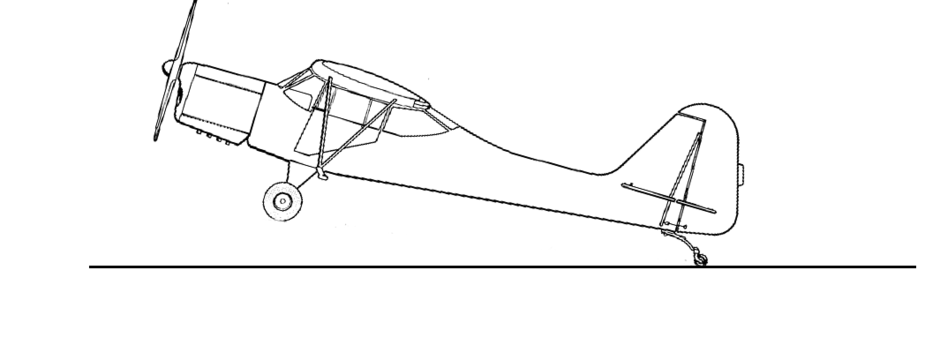Here is the paragraph from Aerodynamics for Naval Aviators on induced drag varying inversely with airspeed.
Here is an example of what a small gust might do when flying deep on the backside of the drag curve and below 1.2 Vs0.
Although I suspect that’s not merely below 1.2 vs0, but more like 1.00001 vs0. I’d have to imagine there’s quite a bit of stall buffet all the time while flying level in that attitude.
A few weeks ago, I measured the pitch attitude as accurately as I could for my aircraft at the moment when the stall occurs, made a diagram of it, and it looks like this – very similar to the aircraft in the video:

“The correct input is to level the wings with the rudder”
I was taught to do that in a stall, but have seen that procedure questioned. Just enough rudder to stop wing drop? Use rudder to keep ball in middle? At his altitude I’d not dare to look inside – lower nose and add power? (Gently!) Or rely on your ground crew’s prayers?
In a STOL aircraft with Vs0 at around 40-50mph CAS, you only need a gust of 5-10mph to be in the stall regime. The lift dependant drag curve goes up more sharply than the non lift dependant, so a gust can place you quite beyond the critical angle of attack – you don’t control AoA that easily in gusty conditions.
The Helio Courier uses spoilers for roll control close to the stall, so using the rudder is type specific.
Old skool you would have learned falling leaf technique which is deep in the stall regime, but very few pilots ever carry out this exercise. Accelerated stalls and falling leaf is a good intro to aerobatics.
RobertL18C wrote:
but very few pilots ever carry out this exercise.
Well, I did it as part of my BFR only last week :-)
But I was flying with a very old school instructor (Joy from Texas Taildraggers out of Houston Southwest, and she’s been flying since the earth cooled).
That’s hardly an approach. He is simply dragging the plane along in horizontal flight with the engine, probably to set it down on the mark with as little energy as possible. A bit more engine power, and he could hoover instead 
Well he was using propwash to keep the plane flying.
Not particularly relevant to most of us.
Could have been a gust or just got too slow.
But a gofundme page? He crashed his plane. Hardly a charity case.
JasonC wrote:
He crashed his plane.
Almost deliberately I would say, looking at that video. Sometimes one gets what one asks for.
JasonC wrote:
Hardly a charity case.
I will happily contribute towards a bicycle for him if he want one. But another aeroplane? Not really.
I have seen loads of similar videos, mostly taken at short landing competitions and in this case a slow flight competition.
These competitions invite these sort of accidents in the same way motor racing invites you to spin off the track.
I won’t be entering.
Yes, these competitions are hardly a demonstration of the most safe way to fly an aircraft. So, when something unsafe happens, it can’t be surprising. How lucky it is for some that there is freedom, and excess to be able to fly this way, for myself, I cherish my freedom to fly at all, so flying this high risk excess does not interest me. When the aircraft is being “hung on the prop”, it is becoming a helicopter, and other forces begin to be a much greater factor. Helicopters generally have tail rotors to overcome these forces. This fellow tourqued himself into a spin.
I have, on occasion, needed to fly powered approaches, and yes, it will place you at higher risk, but not like this. Some water landings, or landings on a less than ideal surface justify dragging the aircraft to a specific point, and then landing short, but I don’t do it from 30 feet up! One may fly a powered “Vref -5” approach, which is a certification requirement that the aircraft must safely demonstrate, but the higher you are further back, and the slower you go, the more risk you bring upon yourself – probably with no benefit.